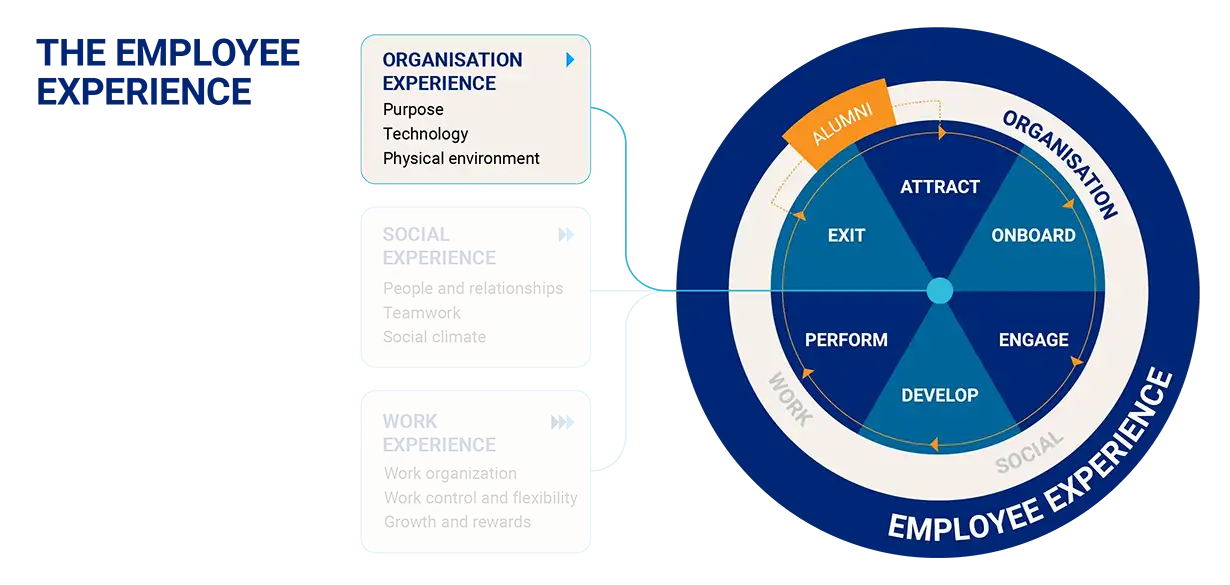Article 2 - Employee experience (EX): Getting your organisation experience right

- How a business is delivering on its purpose in a way that aligns and resonates with workers.
- Setting employees up with the technology, software and hardware, they require to be successful.
- Creating a physical environment that makes them feel engaged and eager to come to the office building.
Purpose and delivering on its promise.
Technology that enables
The physical environment
Implementing a better organisational EX.
1. Purpose: Your action steps
Conduct a company-wide survey to get a better understanding of their perception of your organisation's purpose and whether they feel a connection to it. This can help identify any knowledge gaps, misconceptions, or misalignments and can offer direction on what to prioritise.
Next 12 months:
Make ‘purpose’ part of the daily conversation. Regularly share the company's mission, purpose and values through town-halls, newsletters, intranet communications, office branding, daily meetings and any other mediums you can think of. Making it part of the constant conversation means that you’re signalling its importance to everyone working there.
Embed purpose in every step of the employee lifecycle. You can do this by ensuring every new employee understands the organisation's purpose from day one, and by making the championing of the organisation’s purpose one of the key measures in performance appraisals.
2. Physical environment: Your action steps
Assess the workspace. Does it facilitate collaboration? Are there spaces for focused work? In a hybrid working model, spaces need to be able to meet the demands for various types of work. Survey to understand if employees feel like they have the spaces they need to get their work done effectively, feel engaged and look forward to going into the office to get work done.
Next 12 months:
Build on flexibility and consider offering flexible working hours or remote work options if feasible or look to create spaces with pre-existing workspace that can lend itself to better ways of working. If there’s a section of your office not in use, some tables and seats could be rearranged to provide an alternate area for people to work.
Next two years:
Ask yourself, and your employees, what would make me, and them, want to spend more time in the office? There has been a move towards premium office experiences – make the office nicer than the home and more people will want to spend time there.
3. Technology: Your action steps
Now, more than ever, people are thinking about the what and why of their working lives. Setting short-, mid- and long-term goals can help organisations start to move the needle on the employee experience now while keeping an eye on longer term horizons. Organisations that can do and be more for their people, as well as for their shareholders and customers, will shape the perception of them as an employer, both internally and externally, for years to come.
[1] https://www.mckinsey.com/capabilities/people-and-organizational-performance/our-insights/this-time-its-personal-shaping-the-new-possible-through-employee-experience
[2] https://www.mckinsey.com/capabilities/people-and-organizational-performance/our-insights/help-your-employees-find-purpose-or-watch-them-leave
[3] https://www.forrester.com/press-newsroom/the-next-gen-workforce-five-key-tech-areas-separate-younger-workers-from-older-generations/
[4] https://hbr.org/2023/04/how-your-physical-surroundings-shape-your-work-life
[5] https://www.pwc.com.au/future-of-work-design-for-the-future/designing-a-hybrid-office.html
[6] https://time.com/6280986/hybrid-office-return-to-work-design/
Search for candidates
Management advice
How to decide who gets a pay rise
Manage the performance of contingent workers
Australian Skills Classification
The core skills you need in your talent strategy
Tips for creating a strategic vision
Why you need a succession plan
Diversity, equity, and inclusion activities
The rise of the contingent workforce
Diversity, equity and inclusion
10 Way to Improve Workplace Culture
Mitigating co-employment risks
Leading people through volatile times
Upskilling for an AI Future report
How to reenergise a tired team
Top tips for managing your multi-generational workforce
Why is organisational purpose important and how can you define it?
Managing your contingent workforce
Your introduction to employee experience
Coaching & On-the-job training
Family-friendly work practices
How to conduct a performance review
How to establish if a manager will succeed
Bridging the digital skills gap
Talent management for on-demand staff
Whose responsibility is upskilling?
How to offer career progression
Pros and cons of salary transparency
How to foster innovative thinking in your team
Retention strategies to retain top talent


